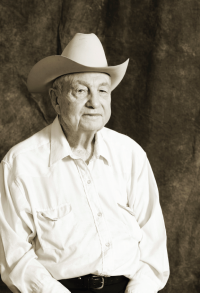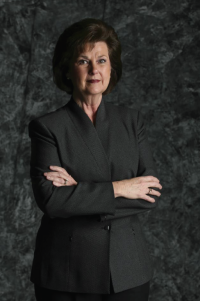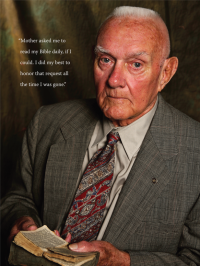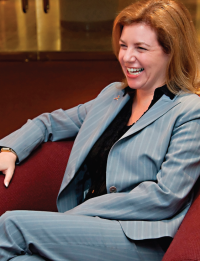One of the things that set Texoma Living! apart is the inclusion in each issue of a long-form profile, usually three thousand words or more, on someone who brings something special to our community. From the beginning, the goal was to offer the reader something more than a superficial glance at the subject. We wanted the reader to finish the story and say, “I never knew that.” This is a very short retrospective of some of those stories.
From the beginning, the marker for profile features was set high. For the first cover of our first issue, then called Sherman Living!, we chose fifth generation Sherman cattleman, Lee Hudgins. Ann-Marie Shumate’s photograph of Mr. Hudgins’ weathered features, marked by more than a half century on the North Texas prairie, captured the essential character of our small part of the world and bridged Texoma’s past to its present.

Lee Hudgins: “Cowman”
Hudgins has a reverence for the land, and he sees in it things others never notice. “So much of the country is cut up,” he said, “not like it used to be,” and as we drive the back roads west of Sherman, he identifies parcel after parcel of land with a hint of nostalgia in his voice. “My father owned that section,” he will say, or, “We used to lease that pasture over there and work cattle on it.
“My father would really be bothered by the condition that pasture’s in today,” Hudgins said as we drove past a field, partially plowed and thick with weeds. “The folks who own it now don’t take very good care of it. They cut part for hay and let the weeds get out of hand. It’d take several years and a lot of work to put it back into shape. But it’s their land, so there’s nothing you can do.”
It is a fine art, managing the land, and it is as much a part of being a real cowman as sitting a horse. He knows when to graze and when to let the land lie fallow and recover. Many of the part-time ranchers, dabblers really, do not have the knowledge or the interest to do it right. And seeing the land misused hurts men who understand it. For in the long run, it is about the cattle and it is about the land, and it is about a way of life that the Hudgins family has been a part of for 150 years.
Sherry Christie: Life at It’s Most Beautiful Best
For issue number two, the rechristened Texoma Living! reached out to Denison and Sherry Christie, a woman whose indefatigable efforts to help the people of Denison have made her one of the community’s most active fund raisers.
“If you asked my kids the things they will remember most about me when I’m gone, they’ll answer you in a heartbeat.”
1. You get what you give.
2. Worse things happen.
3. Live life joyfully; it’s a gift.
4. Every day is what you make it. Think good thoughts and good things will happen.
5. Everyone has feelings. Don’t ever intentionally hurt another person.
6. Smile a lot.
7. Laugh a WHOLE lot!
8. Treasure your friends.
9. Give back, it’s your duty and the rewards are many.
10. Be loyal and true and honest and always keep your word. Don’t cheat.
11. Honor your commitments. Don’t make them until you know you can keep them.
The kids aren’t small anymore. Son Wink graduates from Baylor this year with a major in economics. “He has a personality much like mine; he never meets a stranger, and he’s extremely loyal.” Christie said. “Both of my kids do a lot of volunteer work, and I think part of our job as parents is to pass that on to our kids.”
Like her mother’s, daughter Dustan’s blood runs burnt orange. She’s a Longhorn sophomore in Austin. “She called me one day when she was a freshman just to tell me what an incredibly clear, crisp, beautiful day it was in Austin,” her mother said. “I asked her if she felt like her heart was just so full it might burst, and she said yes, that was exactly how it felt. That is life at its most beautiful best.”

Anna McKinney: Bouncing all the Balls
A year after the story about Sherry Christie, we profiled her best friend, Anna McKinney, the president of the Denison Chamber of Commerce. At its heart it is the story of McKinney’s incredible, courageous, ongoing, still successful battle against cancer, as well as her devotion to her town.
“The day of the Christmas parade in 1995, I had gone to a doctor for a second opinion. I came right up here, straight from the doctor’s office. I had a parade to do. I did the parade and then met my husband at a Christmas party. I sat there beside him and told him I had to go to the hospital in two days.”
It was not supposed to play out that way. Two weeks earlier, the Denison Chamber of Commerce had offered Anna McKinney their top job. She had accepted and was now the new Chamber President. “I was so excited that they had finally recognized my ability and then…” Too often, there is a “then.”
Everything happened so quickly. “I walked out of the office on a Friday afternoon and said, ‘By the way, I won’t be here Monday; I’ve got to go to the hospital and have a test, but I will be here Tuesday for the board meeting.’ That weekend I put up the Christmas tree, and I came down here to get ready for the board meeting. I don’t know why, but something told me to get everything in order.”
A biopsy on Monday confirmed what she instinctively knew. There was no real option, no choice to make, so instead of Tuesday’s Chamber board meeting, she woke up in a hospital recovery room following a mastectomy.
“I looked at it as, I could laugh or cry, and crying wasn’t going to change it. It was a reality,” said McKinney. “I was alive, so I opted to laugh. I put a smile on my face and came back to work. I walked in here, and I couldn’t open my desk drawer. The girls would come in and get everything laid out and I’d start to work.” She had overcome the great unknown that lay beyond that little word “then” and would go right on, day by day.
Roger Sanders: Citizen Sanders
The longest profile we have done to date, six thousand words, introduced readers to another side of one of Grayson County’s most respected, and some would say feared, lawyers, Roger Sanders.
Before the New Mexico sojourn, Sanders had interviewed with a Sherman law firm, so he knew at least a little about the town. He and Cindi had already decided they wanted to live in a community about Sherman’s size, and they had considered Liberty, Tyler, Longview and a few others.
Why small? Why not the buzz of the cities, Dallas or Houston? “Both of us liked the qualities we sensed in a small town, so that’s where we wanted to go, but we didn’t want to go where our relatives were, so that ruled out Temple (he had an uncle there) and Plainview. We were looking for something that felt familiar.
“I needed some place to finish growing up. I had not been socialized. I was a country boy who had been to sophisticated places. My wife made me, good or bad, but I was not a Houston, ‘let’s go hang out with the swinging crowd’ kind of person. That’s just not who I was. She wasn’t either. For all her sophistication, and she had a lot of it, she was a small town girl. A small town fit us, and we thought it was a place our kids could be brought up safe and be educated in a public school system. That was important too, because that’s what you do in a democracy.” Sherman had what Roger and Cindi wanted, and it had something else, a job.
Roger and Cindi moved to Sherman in 1974. Sanders joined the three-man firm (he made it four) of Kennedy and Minshew making half of what he had earned working for the government, but in much more congenial surroundings. “I worked directly with Jack Kennedy doing trial work. He was the best,” Sanders said. “Jack [Kennedy] and Bob [Minshew] never restricted me on the kinds of cases I could take, so I learned about pretty much everything. I had over two hundred case files.”
Fourteen months after starting with the firm, Sanders moved down the street to join Don Jarvis and Ray Grisham. He needed a little more room to take on things he thought were important and make his mark.
Sometime early in his legal career, indeed, well before he hung up his shingle perhaps, Roger Sanders must have read the comment about newspapers by Finley Peter Dunne, “The job of a newspaper is to comfort the afflicted and afflict the comfortable,” and decided it applied to lawyers as well.

Charlie Baum: The Long March Home
In the winter of 2008, we told the stories of two veterans of World War II under the collective title, “Two of Sixteen Million.” Jacquita Lewter wrote about Charlie Baum, from Whitesboro, who survived the Bataan Death March and life as a prisoner of war in Japan.
In the spring of 1944, Baum and other Americans were moved by ship to Japan. “The transport ships that carried us were old antiques,” he said. “They herded us in like cattle. We were prodded on board with bayonets.”
During the ninety-day journey, Baum witnessed American soldiers go crazy with the effects of the malaria and jump overboard into the ocean. There was very little food and very harsh treatment. The transport ships were unmarked, and the two vessels immediately following Baum’s ship were sunk.
When the ship arrived in Japan, Baum and the other men were taken to Osaka where they joined fifty British and 150 Dutch POWs who were already at work in a copper factory. They made copper plates used for submarine batteries.
He would remain here until WWII ended in 1945 and the camp was liberated. He weighed eighty-six pounds when he was freed.
During the forty-two month ordeal, Baum never doubted that he would survive and return home. “I learned to control my mind,” he explained. “I read my Bible as much and as often as I could, just as mother had asked me to do. I made plans for later, after I got home. I thought about survival all the time. Those men who gave up died fast. You learn to get by.”
Leonard Riley: A Soft-Spoken Screaming Eagle
Leonard Riley was a paratrooper with the 101st Airborne Division.
It was Corporal Leonard Riley’s first trip to Europe. He was the second man in the stick, and standing in the door of the C-47 he could see the red streaks of the tracers climbing up from the German flak batteries as if they were reaching out for the airplane, his airplane. When the jump light flashed from red to green, the twenty-year-old machine gunner stepped into the open doorway, grasped the edges of the door-frame the way he had been taught back at Fort Benning, and jumped into the night. Was it really worth the extra fifty dollars a month?
“I jumped at 01:15. When I landed, I was all alone. Everybody was scattered. We were four miles from where we should have been. To assemble, the first men to jump were supposed to follow the line of flight and the last out were to go in the opposite direction.
“During training, the British had come up with a leg bag. You tied it to your leg with a jump rope, and it had a little rip cord. The idea was after your parachute opened, you’d reach down and pull the ripcord and let the bag down on the rope so you didn’t land with it. My bag had a machine gun in it, and it was so heavy and pulling down, that I could not reach the ripcord, so I landed with it. It could have broken my leg, but it didn’t.
“It was very dark. I don’t remember moonlight. I crossed a little farm road and into a ditch full of water. I was alone, in the dark, and I was wet.” The Germans had flooded the field behind the Normandy beaches, and many paratroopers drowned in the dark.
Riley got out of the ditch and went back to his landing spot. There he met one of the men in his squad. “He was supposed to have a machine gun, but he had lost all his equipment except for a machete.”

Lisanne Anderson: News at Six
Probably the most read profile we have done was the Lisanne Anderson story. When the long- time local TV news anchor suddenly disappeared from the screen, people wanted to know why.
After a round of good mornings, the general manager said, “There’s no easy way to put this, but we’re going to have to lay you off.”
Anderson was stunned. “I never moved. I just sat in the chair and stared at the table.”
Dean talked about the economy, the tight budgets, the layoffs the station had already made, but the explanations, however logical they might have been, merely provided background noise for Anderson’s thoughts—“Why me? I’ve been here eleven years.”
“He kept saying the same things over and over. ‘It’s corporate wide…you’re not the only one…there are other people who have been here longer than you have,’ adding that the timing, the day after my contract had expired, was just ironic.” The other two people in the room said nothing. “Charlie didn’t even look at me,” Anderson said.
She peppered her now former boss with questions. “I wanted to know more, but he said my questions were irrelevant. At that point, he said the words that I will never forget. ‘I’m going to ask that you leave the building. You will be escorted out.’ And I was asked to go back to the newsroom, pick up my purse, and leave.”
Reporters get used to the shock of unpleasant situations. They see them, they hear about them and then they go back and write about them. They learn to separate their own feelings from their stories so they can judge the facts fairly, not without compassion to be sure, but objectively.
Anderson’s reporter’s instincts raised unanswered questions, and her reporter’s detachment allowed her to control her demeanor as she tried to make sense, or order, or reason out of what had just happened. She asked about her things in the newsroom, pictures, books, the accumulated belongings of eleven years, and was told, “We will make sure you get your things.”
“I said, ‘You got it.’ I didn’t cry. I think I got a little misty eyed there at the end, but I didn’t cry.” And then it overwhelmed her.
“When I started walking down the hall, the tears just started coming. I remember seeing my feet walking quickly and hearing the person behind me trying to keep up. I kept saying to myself, ‘Don’t fall apart. Just get the hell out of here.’”
Anderson walked into the newsroom where it was business as usual. No one knew what was happening. No one turned around. She picked up her purse, some clothes and her makeup kit and walked back down the hall and out the door, escorted all the way to her car by her temporary shadow. Eleven years had been closed out in twenty minutes.
Bill Douglass: A Matter of Convenience
Sherman’s Bill Douglass left the highest levels of corporate America to come to Grayson County and sell gasoline and soda pops. Now his Lone Star convenience stores are familiar to everyone. We explored his quest for something different.
A few years ago, he planned to build a store with the first fast-but-elegant dining concept anywhere at the intersection of US 75 and FM 691. The idea was top-class food, served in an atmosphere of casual elegance for travelers looking for more than a hamburger and a Coke.
The idea fell by the way when Sherman went wet. “Its claim to fame was that it would have been the closest source of alcohol to Sherman, and that would have helped support that elaborate dining idea. We had a fabulous, fabulous design for that place. It would have been the most elegant facility in the county.”
The original plan called for a butterfly atrium. “We were going to get the butterflies from Costa Rica,” said Douglass, “but we learned that the Department of Agriculture had all these requirements about the butterflies. We had to have all kinds of elaborate measures so the butterflies couldn’t escape, and when they died, we had to dispose of them like medical waste. And another thing the people in Costa Rica didn’t tell us until we had $80,000 invested in this thing, we would have to keep the temperature at 80 degrees and the humidity at 80 percent.
“Well that killed the butterfly thing, and it killed our enthusiasm for the elaborate thing. We were trying to build a destination. We had $1,000,000 in the ground and $140,000 in the design, but it just wasn’t going to work anymore.” Douglass eventually got his money out of the property, but he still thinks wistfully about those butterflies. Sometimes it is risky to think so far outside the frame.
Marjorie Hass: Two Sides of the Paper
It was a different profile in that it was not about someone already known in the community. Marjorie Hass was brand new to Sherman, to Texas, and to her job as the 15th president of Austin College when we introduced her to Texoma.
“There is a passage in the Talmud that I think about a lot,” said Marjorie Hass. “It says that you should have a piece of paper that on one side says ‘I am but dust and ashes,’ and on the other side it says, ‘The whole world was created for my sake.’ The trick in life is to know when to turn the piece of paper over and look at the other side. Anytime you have a position that has this much responsibility and this much privilege, you have to live like that.”
This dichotomy, the delicate balance between humility and hubris, enables one to embrace new and otherwise daunting challenges with equanimity. So far in her career, Hass has turned the paper over at the appropriate times, but never before have the personal and professional stakes been quite so high or the expectations quite so looming.
Hass is the fifteenth President of Austin College, the oldest college operating under its original charter in the state of Texas. At forty-four, she is young for the job and far more attractive than the words “college president” would conjure up in the minds of most people. She is Jewish, and some might find that unusual for a Presbyterian school in the Southern Bible Belt, but in an increasingly pluralistic society that may not matter so much anymore.
AC is betting that their new president has star power. A two-part ad in the September issue of Texas Monthly prominently features President Hass as the new face of Austin College. In an academic environment where colleges often vie for the qualified students the way football powers battle for Friday night heroes, associating the old school with the bright new look of a young academic might just tip the scales for a high-school senior trying to decide where to go next.
Who’s next?
Since we began, we have also profiled former county judge Horace Groff, Sherman volunteer Joan Douglass, up and coming investment advisor Justin Dobbs, and Denison’s ice cream man, Bill Ashburn. This year we have offered our readers a longer look at Kent Black, the retired aerospace executive who is building the new Reba’s Ranch House, and Denison football coach Cody White. Who’s next?

